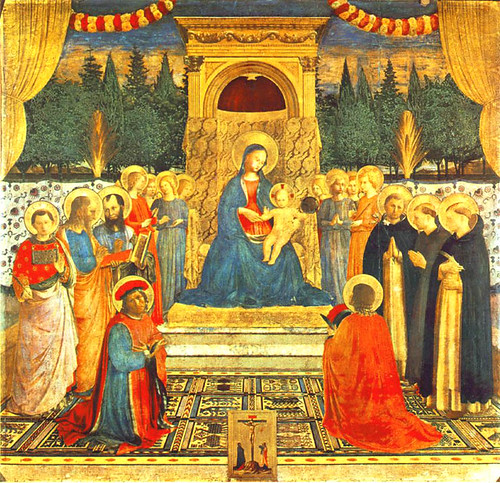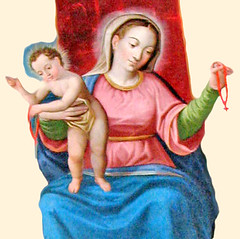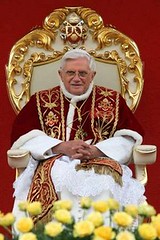A Triduum in honour of Fra Angelico

Our Dominican brother, Blessed John of Fiesole (c.1386 - 1455), has the privilege of being the only artist raised to the altars of the Church. There is no doubt that great art existed in Florence both before and after his time, but when a great painter is also a saint, his work is suffused with a holy light and a purity of style that points towards the One who is Beauty itself, the One who reveals the holiness of beauty.
Called 'the angelic friar', Bl John of Fiesole contemplated the radiant face of Christ and handed on the fruits of his contemplation in works of art which reflected the beauty of holiness. As such, the biographer and art historian Giorgio Vasari said that "the saints [Fra Angelico] painted have more the air and likeness of saints than those of anyone else." This was possible because he was a saint himself. To celebrate this saint and artist whose feast falls on Saturday, I shall be posting a Triduum of articles on Beato Angelico and I am indebted to Professor John Saward's 'The Beauty of Holiness and the Holiness of Beauty' and William Hood's 'Fra Angelico at San Marco' for much of the following.
We begin today by contemplating aspects of Fra Angelico's altarpiece for the Dominican Priory of San Marco in Florence where he lived and produced work for between 1438 and 1452. This altarpiece, Ruskin tells us, was intended by Beato Angelico to be his masterpiece and Vasari said it was "especially beautiful and marvellous". The Priory of San Marco was given to the Order by Cosimo de' Medici as an Observant Dominican house, this being a reform movement in the Order of Preachers to return a stricter observance of the Constitutions. After years of re-modelling, San Marco was ready for the Observant Dominicans to move in and the priory was dedicated on the Feast of the Epiphany in 1443. Nevertheless, Fra Angelico had already begun the altarpiece for San Marco in 1439 and was to decorate the walls of the newly renovated priory with frescoes for years to come. The priory was thrust into prominence in the 1490s when Fra Savonarola was prior there and it was the scene of a siege and his dramatic arrest by the mob on 8 April 1498.
Stylistically, Bl John's work stands at the cusp of the formal and stylized Byzantine iconographic style and the classical realism of the Renaissance. As such, it is particularly suited to religious art, often of a catechetical nature and Fra Angelico's art in San Marco represented the Observants' ideals of Dominican life. What is noteworthy about many of the paintings of Christ's life is the inclusion of a Dominican, kneeling in contemplation of the scene, a kind of visual representation of what the Dominican saw in his mind's eye as he meditated on and preached the Word and prayed the Rosary.
The altarpiece in the choir of San Marco, where the friars celebrated the Liturgy, was at the very heart of the priory's life. Here, the friars gathered for Mass and the Divine Office and they did so in the invisible presence of the saints and angels, made visible in the altarpiece. Moreover, from the late 13th-century, the Dominicans began to reserve the Blessed Sacrament in a tabernacle on or above the altar itself rather than in a side chapel or the side wall of the choir (in a 'sacrament tower') as was then the custom. This Dominican innovation centred the friars' attention on our Eucharistic Lord, making the altarpiece which surrounded the tabernacle a particularly important reminder of the Lord's Presence.
In many ways, Fra Angelico's altarpiece was rooted in the Dominican life and customs and reminded the friars of what they should carry with them into the priory when their work in the church was accomplished. However, it is also a radical departure from altarpieces that came before; there is no golden background (as one still finds in Byzantine icons), gothic gables and surrounds and the setting is naturalistic and the figures realistically proportionate. Sadly this exquisite and brightly coloured painting was devastated in the 19th-century when it was cleaned with caustic soda thus fading some of the colour and detail.
The saints of the altarpiece are all patrons: St John the Evangelist (patron of Cosimo de' Medici's father and of Bl John of Fiesole himself), St Mark (patron of the convent), St Lawrence (for Lorenzo de' Medici, Cosimo's dead brother), St Dominic, St Peter Martyr (protomartyr of the Order) and St Francis (our Seraphic Father and spiritual father of mendicant friars). It is noteworthy that the Dominican General Chapter of Budapest in 1254 mandated that images of Ss Dominic and Peter Martyr be placed in all Dominican churches. In the foreground kneel Ss Cosmas and Damian, patrons of the Medici family. These saints are in conversation, displaying a communion of saints and we are invited into this scene by St Cosmos who is gesturing us into their midst. Moreover, the curtains are pulled back fully to reveal this vision of Paradise. As we on earth enter into conversation with these heavenly patrons, there emerges a sacra conversazione (as art historians call it) between heaven and earth.
At the centre of the altarpiece is the Christ Child, nude and enthroned with His Mother and holding the orb, signifying his universal kingship. This orb, rather unusually, is actually painted with a map of the world with Jerusalem in the centre. The figure of Christ is surrounded by attendant angels holding instruments of the Lord's Passion by which He won Kingship of this world. This is significant as the priory was dedicated on the Feast of the Epiphany when the kings of the earth knelt before the sovereign Lord and San Marco was long a focus of the Florentine people's Epiphany celebrations. The saints and angels are gathered as at a royal court, the throne with its classical entablature (in tribute to Burnelleschi whose work was all the rage in Florence then) set on a lavish carpet and surrounded by sumptuous hangings and cloth of gold.
The Order of Preachers has always had a special devotion to Our Lady, seeing her to have founded the Order herself and to be its Protectress. In addition, she is the "vanquisher of heresy" and her presence and that of the Lord, naked and vulnerable, is a reminder of the reality of the Incarnation. Indeed, Guy Bedouelle, OP notes that "[Fra Angelico's] painting never ceases to speak of the Incarnation." Thus, through his art, the angelic friar preached the central message of the Friars Preachers. As the Order was founded to defeat the Albigensian heresy which was an extreme form of dualism that deplored the flesh and denied the Incarnation, it is only to be expected that the Our Lady and the Christ Child is at the centre of the altarpiece. In fact, she is a dominant figure in Dominican art and references to her permeates the San Marco altarpiece, like perfume fragrances the air.
The landscape behind her is actually a reference to Ecclesiasticus 24:13-16, where Wisdom - who is personified in Our Lady - is likened to cedars of Lebanon and cypresses, palms and olives, to fragrant and fruiting trees, all represented here. Moreover, the trees are in an enclosed garden and the Fathers referred to Mary as the 'hortus conclusus', a mark of her fecund virginity. This garden stretches down to the sea, a reminder of the Marian Office hymn wherein she is called the 'stella maris', the star of the sea. The roses that festoon the upper reaches of the painting are reminescent of the Rosary which is a famously Dominican devotion. But most explicitly, the altarpiece contains quotations from the Dominican Little Office of the Blessed Virgin Mary: in her mantle is inscribed "I am the mother of beautiful love... and of holy hope"; "Like a vine I caused loveliness to bud, and my blossoms became glorious and abundant fruit." And indeed there is a serene beauty about her that comes from the light of her Son and this beauty is reflected in the saints, her spiritual children, gathered around her.
Another element present in the altarpiece is the reference to preaching. Dominican altarpieces frequently had apostles or preaching saints present to show that the Order stood in the line of preachers stretching back to the apostles. The Dominican motto: "Contemplata aliis tradere", 'To pass on to others the things contemplated' is indicative of the raison d'etre of the Order of Preachers. Here in the San Marco altarpiece, the evangelist Mark is showing the Gospel he has written to the evangelist John; literally passing on his Gospel words to another. On this codex is written the text from chapter 6 of his Gospel in which Jesus sends out his disciples in pairs to preach the Gospel, bound to poverty and empowered by the Holy Spirit; a clear reference to the Dominican friars who follow in their footsteps. The posture of Ss Cosmas and Damian also indicate the twin aspects of the motto above, as one gazes upon the Holy Face and the other is turned towards us, exhorting us to look to Christ.
Finally, we ought to note the little crucifix at the bottom. This actually stood above the altar of sacrifice where the Holy Mass was offered. Taken in its complete context, it is another of Fra Angelico's visual sermons. He reminds us that in the flesh that He took from the Virgin Mary, Jesus truly suffered and died, in that flesh He rose again and ascended to the Father and with that flesh he now feeds us in the Eucharist at that altar.
As the friars of San Marco received and adored the Lord truly Present in the Eucharist, heaven was really present and this altarpiece enfolded the friars within the blessed company of Paradise with the saints and angels, with Our Blessed Mother and especially with the Lord who gave Himself to them in the Eucharist. The perpetual Presence of Christ in the tabernacle made a little heaven out of the company of his disciples gathered there in prayer in the choir of San Marco. Where His Body was, there was the king. And where the king was, there was his kingdom.
This was Beato Angelico's sermon, his holy preaching and he convey continues to preach Christ Incarnate through his sublime art. Thus, Pope John Paul II said in his Apostolic letter of 1982: "It is evident that Brother John, because of his rare gifts placed at the service of his art, has been of immense spiritual and pastoral usefulness to the people of God. And he continues to be so, for even today his art makes the way to God more accessible for us."
Let us pray:
"God of eternal beauty,
in your providence you inspired Blessed Fra Angelico
to reveal in images of earth
the tranquil harmony of heaven.
With the help of his prayers
and by following his example
may our lives reveal that same splendour
to the hearts of all our brothers and sisters.
Through Christ our Lord."
Amen.







2 Comments:
I'm listening right now to a Radio Vatican program on Fra Angelico. The narrator is reading a long passage from John Paul II's letter on Fra Angelico. Speaking now of the book of his sermons using his paintings for catechesis.
I visited his tomb in Sta. Maria sopra Minerva a couple of months ago. It was sort of a threefer...Fra Angelico, Catherine of Siena, and Michelangelo's Risen Christ.
>>>But most explicitly, the altarpiece contains quotations from the Dominican Little Office of the Blessed Virgin Mary: in her mantle is inscribed "I am the mother of beautiful love... and of holy hope"; "Like a vine I caused loveliness to bud, and my blossoms became glorious and abundant fruit." <<<
Is this quote taken from a visit by th Blessed Mother to St. Dominic? There is much confusion about it. I would be grateful if you could settle it. People are saying Mary said it and in today's milieu with the many false apparitions it's so important we straighteen it out! Thank you for your help.
Post a Comment
<< Home